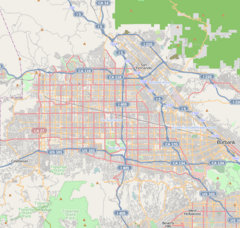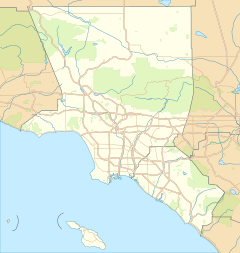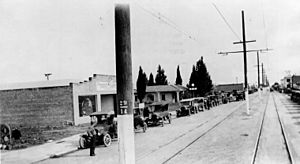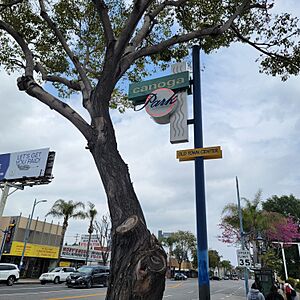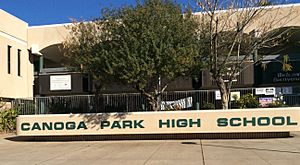Canoga Park, Los Angeles facts for kids
Quick facts for kids
Canoga Park, Los Angeles
|
|
|---|---|
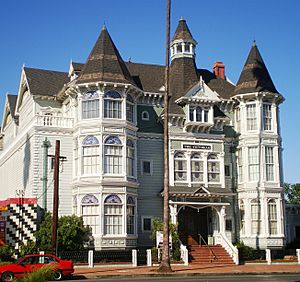
The Platt Building, also known as The Victorian — a c. 1970s office building at 19725 Sherman Way, Canoga Park−Winnetka, photo taken in 2008
|
|
| Owensmouth | 1912 |
| Canoga Park | 1931 |
| Named for | Canoga, New York |
| Area | |
| • Land | 4.35 sq mi (11.3 km2) |
| Elevation | 797 ft (243 m) |
| Population
(2008)
|
|
| • Total | 60,578 |
| Time zone | UTC−8 (PST) |
| • Summer (DST) | UTC−7 (PDT) |
| ZIP Codes |
91303, 91304, 91305, 91309
|
| Area code(s) | 818 and 747 |
Canoga Park is a neighborhood in the San Fernando Valley area of Los Angeles, California. It has a rich history, from being part of a large ranch to becoming a town. The area was first called Owensmouth when it was founded in 1912. It later joined Los Angeles in 1917. On March 1, 1931, its name was changed to Canoga Park. This new name came from Canoga, New York.
Contents
Exploring Canoga Park's History
Early History of Canoga Park
The land where Canoga Park is today was once home to Native American tribes. These included the Tongva-Fernandeño and Chumash-Venturaño tribes. They lived in the Simi Hills and along the streams that flow into the Los Angeles River. These groups traded with the Tataviam-Fernandeño from the northern Valley. Native American cultures lived in the Valley for about 8,000 years. They left behind important sites like the Burro Flats Painted Cave.
From 1797 to 1846, this area was part of Mission San Fernando Rey de España. After Mexico became independent from Spain, the land became part of a large ranch called Rancho Ex-Mission San Fernando. In 1845, a special land grant was given to three Chumash people. This land, called Rancho El Escorpión, was located west of Fallbrook Avenue.
How Canoga Park Grew in American Times
In 1863, a group led by Isaac Lankershim and Isaac Van Nuys bought the southern part of the San Fernando Valley. They started large wheat farms. They were the first to send California wheat to Europe. In 1869, Alfred Workman bought a huge 13,000-acre wheat farm in what would become Canoga Park. He also brought eucalyptus trees from Australia to the San Fernando Valley. These trees spread widely and are thought to be the ancestors of many eucalyptus trees in Southern California.
The southern San Fernando Valley was divided into smaller plots. This happened before the Los Angeles aqueduct was finished in 1913. Important people like Harry Chandler and Harrison Gray Otis (from the Los Angeles Times) bought land. Moses Sherman, who built streetcar lines, and Hobart Johnstone Whitley, a real estate developer, were also involved. Whitley helped plan many towns, including Hollywood.
The area was first named Owensmouth by Hobart Johnstone Whitley. He wanted people to think it would be the new "mouth" of the Owens River. This was because the Los Angeles Aqueduct was bringing water from the Owens River. The town was founded on March 30, 1912. The Janss Investment Company helped sell properties. To promote the town, Pacific Electric streetcars and a main road (Sherman Way) were built. They stretched from Hollywood through Cahuenga Pass to Van Nuys. A special racecar called the "Owensmouth Baby" was used to show off the new paved Sherman Way. It could go an amazing 35 miles per hour!
Owensmouth was a small community. It used "baby" themes in its ads, even showing storks. Because it didn't have its own water supply, it had to join Los Angeles. This happened on February 26, 1917. The name was changed to Canoga Park in 1931. This was thanks to the efforts of a local leader, Mary Logan Orcutt. The area was mostly farms, growing fruits, vegetables, and melons. It also had some livestock and horses. There was even a movie studio and stunt location.
Canoga Park's Recent Past
In 1955, Rocketdyne, a part of North American Aviation, opened a large factory in Canoga Park. This became a major employer. Other aerospace companies like TRW, Hughes Aircraft, and Boeing also came to the area. Many smaller businesses grew to support the aerospace industry. Rocketdyne eventually became Aerojet Rocketdyne. They moved out of Canoga Park in 2014. The old Rocketdyne factory was taken down starting in 2016. The Santa Susana Field Lab, another facility, has also closed. It is being cleaned up and will become an open-space park.
In 1987, a large part of western Canoga Park was renamed West Hills. In 2005, Canoga Park was recognized as an All-America City.
Over the years, some industrial activities in Canoga Park used certain chemicals. These chemicals, like cleaning solvents, caused concerns about groundwater in the area. Environmental tests have shown that some chemicals spread beyond the original factory sites. Cleanup efforts are ongoing to make sure the environment is safe. Residents near these sites have been informed about the testing and results.
Canoga Park's Geography
Canoga Park is surrounded by other neighborhoods. Woodland Hills is to the south, West Hills to the west, Chatsworth to the north, and Winnetka to the east.
Several creeks flow through Canoga Park. These include Bell and Dayton Creeks from the Simi Hills. Arroyo Calabasas (Calabasas Creek) comes from the Santa Monica Mountains. These creeks are the starting points for the Los Angeles River. The Los Angeles River itself begins where Calabasas Creek and Bell Creek meet, right behind Canoga Park High School. Even though these creeks are now in concrete channels, they are important for urban wildlife. They help support the animals that still live in the San Fernando Valley.
Canoga Park's Climate
Canoga Park has hot and very dry summers. It has a hot-summer Mediterranean climate. This means it has mild, wet winters and hot, dry summers.
| Climate data for Canoga Park, Los Angeles | |||||||||||||
|---|---|---|---|---|---|---|---|---|---|---|---|---|---|
| Month | Jan | Feb | Mar | Apr | May | Jun | Jul | Aug | Sep | Oct | Nov | Dec | Year |
| Mean daily maximum °F (°C) | 67 (19) |
69 (21) |
71 (22) |
77 (25) |
80 (27) |
87 (31) |
94 (34) |
95 (35) |
91 (33) |
84 (29) |
74 (23) |
68 (20) |
80 (27) |
| Mean daily minimum °F (°C) | 41 (5) |
42 (6) |
43 (6) |
46 (8) |
50 (10) |
54 (12) |
57 (14) |
58 (14) |
56 (13) |
51 (11) |
43 (6) |
40 (4) |
48 (9) |
| Average precipitation inches (mm) | 3.95 (100) |
4.11 (104) |
3.52 (89) |
0.83 (21) |
0.28 (7.1) |
0.06 (1.5) |
0.01 (0.25) |
0.16 (4.1) |
0.24 (6.1) |
0.57 (14) |
1.41 (36) |
2.17 (55) |
17.32 (440) |
Canoga Park's Population and People
In 2000, about 53,227 people lived in Canoga Park. This means there were about 12,240 people per square mile. This is an average population density for a city neighborhood. By 2008, the population had grown to an estimated 60,578. The average age of residents in 2000 was 30 years old, which is also typical for the area.
Canoga Park is known for having a "highly diverse" mix of people. In 2000, the population was about 50.9% Latino, 30.7% White, 11.1% Asian, 4.3% Black, and 3.1% other groups. Many residents were born outside the U.S. (42.8%). The most common birthplaces for these residents were Mexico (45.8%) and El Salvador (11.6%).
The average yearly household income in 2008 was $51,601. This is considered average for the city. Most homes (63.6%) were rented, while 36.4% were owned. The average household had three people. About 18.1% of families were headed by a single parent. Both these numbers are typical for city neighborhoods. Canoga Park also has a high percentage of young adults (19 to 34 years old). Many men (40.4%) in the area had never been married.
Canoga Park's Economy
Canoga Park is home to the main office of Electro Rent, a company that provides electronic equipment.
Parks and Recreation in Canoga Park
- Lanark Recreation Center, once called Orcutt Park, is a city park in Canoga Park. It has a lighted baseball field and another unlighted one. There are lighted indoor and outdoor basketball courts, and a play area for children. The park also features a lighted football field, an indoor gym, picnic tables, a lighted soccer field, lighted tennis courts, and lighted volleyball courts. It also has an auditorium and is a drop-in site for the Los Angeles Police Department.
- Lanark Pool is an outdoor pool located at the park. It is open seasonally and is not heated.
Education in Canoga Park
About eighteen percent of Canoga Park residents aged 25 and older had a four-year college degree by 2000. This is an average number for both the city and the county.
Here are some of the schools located within Canoga Park:
Public Schools
The Los Angeles Unified School District serves the community.
- Canoga Park High School, 6850 Topanga Canyon Boulevard
- Owensmouth Continuation School, 6921 Jordan Avenue
- Canoga Park Middle School, 22250 Elkwood Street
- Canoga Park Elementary School, 7438 Topanga Canyon Boulevard
- Multicultural Learning Center, a charter school, 7510 DeSoto Avenue
- N.E.W. Academy Canoga Park, 21425 Cohasset Street
- Hart Street Elementary School, 21040 Hart Street
Private Schools
- Canoga Park Preschool and Kindergarten, 7839 Topanga Canyon Boulevard
- Faith Baptist School, for students from kindergarten to 12th grade, 7644 Farralone Avenue
- AGBU Manoogian-Demirdjian School, for students from kindergarten to 12th grade, 6844 Oakdale Avenue
- Canoga Park Lutheran School, an elementary school, 7357 Jordan Avenue. This school was formed by combining Trinity Lutheran High School and Canoga Park Lutheran School.
- Coutin School, Inc. (for students with special learning needs) 7119 Owensmouth Avenue
- Our Lady of the Valley Elementary School, 22041 Gault Street
Famous People from Canoga Park
- Judith Barsi (1978–1988), actress
- Dorsey Burnette (1932–1979), singer-songwriter
- Bob Burns (1890–1956), comedian, actor
- Bryan Cranston (b. 1956), actor
- Mustafa T. Kasubhai, first Muslim-American federal judge in the United States
- Francis Lederer (1899–2000), actor, honorary mayor of Canoga Park
- Meghan, Duchess of Sussex (b. 1981), member of the British royal family and former actress
- Eric Nolte, (b. 1964), former pitcher for the San Diego Padres
- Jimmy Osmond, (b. 1963), singer, businessman, actor, entertainer
- Eugene Selznick (1930–2012), volleyball player
- Mark Turenshine (1944–2016), American-Israeli basketball player
- Randy Wolf (b. 1976), baseball player
See also
 In Spanish: Canoga Park para niños
In Spanish: Canoga Park para niños


